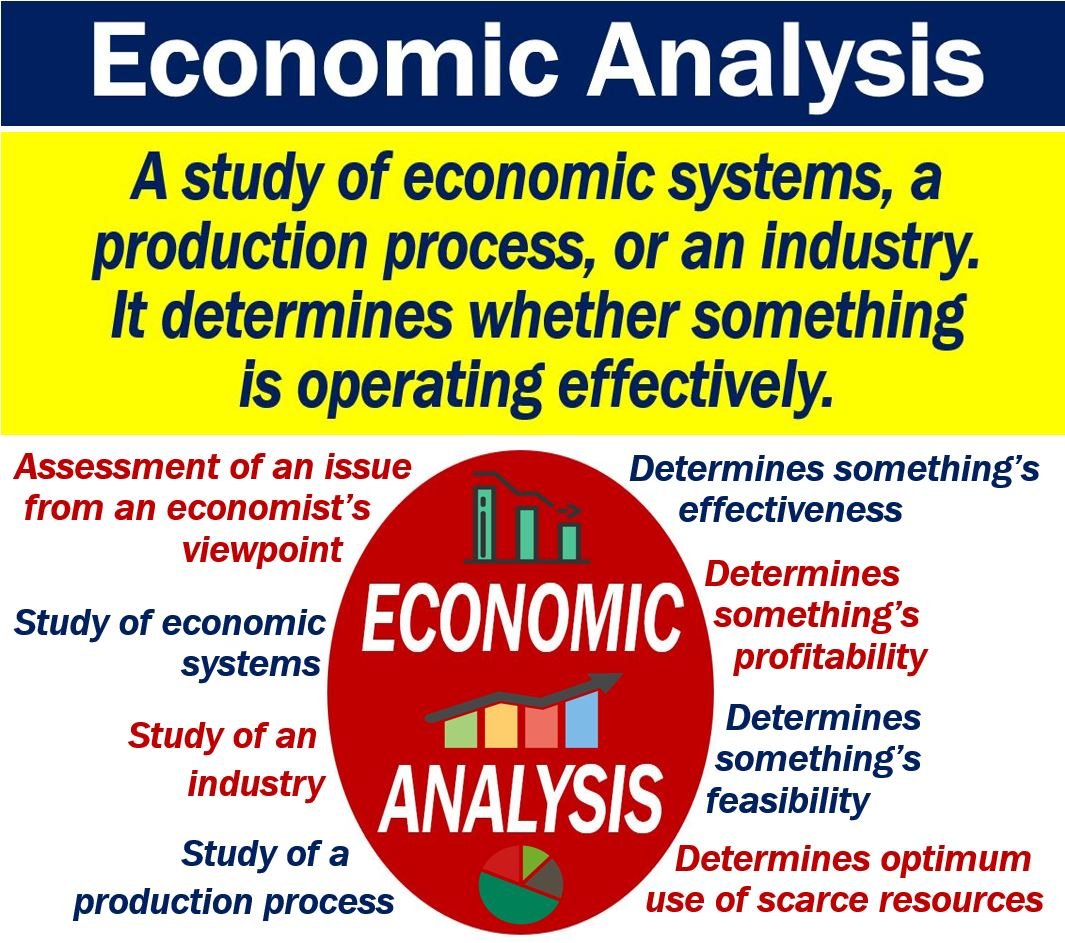What is economic analysis? Definition and examples
Economic Analysis involves assessing or examining topics or issues from an economist’s perspective. Economic analysis is the study of economic systems. It may also be a study of a production process or an industry. The analysis aims to determine how effectively the economy or something within it is operating. For example, an economic analysis of a company focuses mainly on how much profit it is making.
Economists say that economic analysis is a systematic approach to finding out what the optimum use of scarce resources is.
Economic analyses factor in the opportunity costs that people or companies employ. They measure, in monetary terms, what the benefits of a project are to the economy or community.
Opportunity cost is all about evaluating the option you gave up when you made a choice.
The Cambridge Dictionary has the following definitions of “economic analysis”:
“1. A study of an economy or group of economies, or these types of studies in general. 2. A study of the finances of a business, done especially in order to save money and reduce waste.”
Put simply; economic analysis is all about analyzing the economic aspects of something.
Apart from economists, statisticians and mathematicians may also carry out economic analyses.

According to the Asian Development Bank: “Economic analysis is a means to help bring about a better allocation of resources that can lead to enhanced incomes for investment or consumption purposes. Therefore, it is best undertaken at the early stages of the project cycle.
Economic analysis – methods
For companies, the goal of an economic analysis is to provide a clear picture of the current economic climate. Specifically, what the impact of the economic climate is or might be on the company’s ability to operate commercially.
In this context, ‘economic climate‘ means ‘economic conditions,’ i.e., the state of the overall economy.
The people conducting the analysis carry out an in-depth appraisal of the market’s strengths and weaknesses. They may choose from several different methods.
-
Cost/benefit analysis
This type of economic analysis tries to determine a project’s feasibility. Some people may refer to it as a feasibility study.
Those carrying out the study weigh its costs against its potential benefits.
A business may perform a cost-benefit analysis before, for example, purchasing four robots for the warehouse. Each robot can do the work of five human workers.
Currently, the business has 20 warehouse employees. They earn $30,000 per year each, i.e., they represent a total annual wage bill of $600,000.
Without factoring in wage increases and inflation, the business will have spent $6 million on warehouse staff over a 10-year period.
The robots cost $150,000 each. The price includes ten years of free maintenance. Therefore, the cost of automating the warehouse is $600,000.
The company must also employ a roboticist, whose salary is $50,000 per year.
Over a ten-year period, the cost of the robots plus the roboticist will be $600,000 + $500,000 = $1.1 million.
The company will save $4.9 million over that ten-year period if it replaces the human workers with robots.
It might save even more after that because nobody knows for certain how long the robots will last.
After looking at the cost/benefit analysis, the directors will probably decide to go ahead with the project.
Many sociologists and economists today warn that automation will soon take millions of human jobs. What will society be like in future if most people are unemployed?
The subject of automation is not only present in companies targeting manufacturing, it’s also quite present in service industries as well. For example, financial companies all over the world have been planning to re-adjust their operations departments.
Although companies can afford to have employees similar to the past, the reality of the modern markets has shifted so much towards a profit-oriented policy that employees are simply not a focus anymore
-
Cost/Effectiveness
In this type of analysis, we weigh a project’s effectiveness against its price. In this case, however, a low cost does not necessarily mean superior effectiveness.
Using the same ‘warehouse and robots’ scenario, researchers have also determined that human workers are better at spotting defects.
The warehouse workers’ duties do not include checking the quality of the goods. However, they often identify faults and report them.
The company addresses the defects before shipping out the products.
The cost/effectiveness analysis finds that losing this fault detection feature might cost more than $4.9 million over a decade.
The company will probably lose some dissatisfied customers. Additionally, fixing defects after delivering products is much more expensive than doing so beforehand.
After reading the cost-effectiveness analysis, the directors may halt the project. Perhaps one of them may suggest purchasing the robots but keeping on one or two human workers.
Cost/benefit and cost/effectiveness analyses are just two of several types of economic analyses.
These methods, along with others like risk assessment and environmental impact studies, provide a comprehensive view for economic decision-making.
These analyses methods contribute to the economic assumptions that economists make when they create economic models.
Two Videos
These two educational videos come from our sister channel on YouTube – Marketing Business Network. Using easy-to-understand vocabulary and examples, they explain what “Economic Analysis” and “Increasing Opportunity Cost” mean.
-
What is Economic Analysis?
-
What is Increasing Opportunity Cost?

